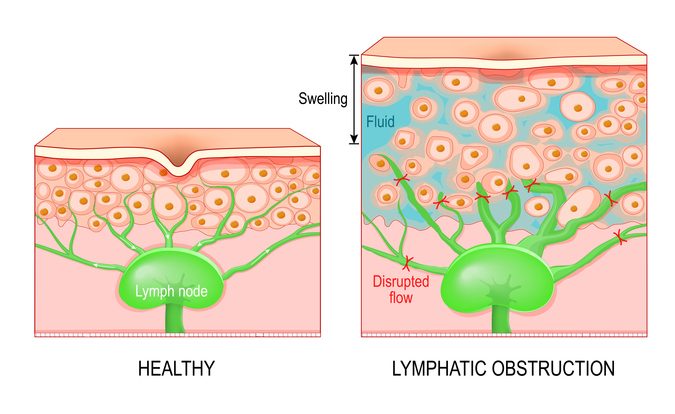Cancer-Related Lymphedema

Lymphedema as a Side Effect of Cancer
Cancer and its treatments can cause lymphedema, a condition that causes swelling due to a buildup of lymphatic fluid.
Lymphedema is most commonly a side effect of treatments for breast, gynecologic, prostate, melanoma, and head and neck cancers. The lymphatic drainage system is a network of vessels and nodes that prevents infection and keeps the immune system healthy by removing excess fluid, waste and germs.
Certain types of cancer treatments can disrupt the body’s lymphatic drainage system.
Radiation therapy can scar or damage lymphatic vessels, while some chemotherapy drugs can weaken lymphatic function. The surgical removal of lymph nodes can disrupt the normal flow of lymph fluid.
Peripheral lymphedema, the most common type, is caused by a buildup of fluid in the tissues of a limb, most commonly the arm or leg. The lymphedema usually affects one limb and causes gradual swelling that builds up slowly over time in that specific area.
Contact Us
Signs of lymphedema
Lymphedema can develop soon after treatment or years later, making long-term monitoring important. Early detection and management can greatly improve outcomes. Patients may experience skin changes, limb pain and discomfort, and restricted range of motion in the beginning. As the condition gets worse, skin overgrowth or cobblestoning, a bumpy, uneven texture on the skin that looks like cobblestone pavement, often appears.
How is lymphedema treated?
Peripheral lymphedema cannot be cured; however, early treatment can significantly reduce symptoms and prevent progression.
Complete Decongestive Therapy (CDT) is the mainstay of treatment for peripheral lymphedema. The aim is to improve patient comfort, decrease swelling and fluid buildup to bring the limb back closer to its normal size. CDT consists of general measures patients can take at home to monitor and care for the condition, using compression bandages or garments to reduce swelling and specialized physical therapy exercises. for monitoring and self-care, compression therapy, and physiotherapy, usually under the guidance of lymphedema expert, preferably a certified lymphedema therapist.
This treatment is usually done with the help of a lymphedema expert, ideally a therapist who is specially certified in lymphedema care. Patients with severe lymphedema symptoms that haven’t improved with standard treatments may be referred for a surgical evaluation.
Surgery can involve:
- Physiologic procedures, such as lymph node transfer or lymphovenous bypass, which aim to restore or improve the flow of lymph fluid.
- Reductive procedures, which involve removing excess tissue to reduce the size of the swollen area.
These options are typically considered when conservative (non-surgical) treatments haven’t worked well enough to meet the patient’s health or quality-of-life goals.






Comments